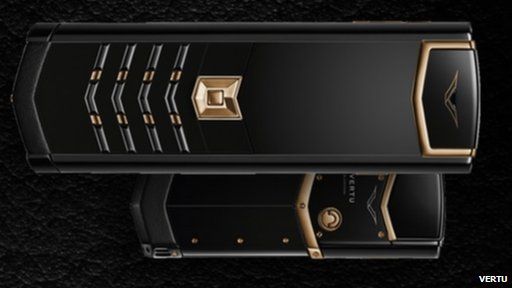
-
3 August 2015
- From the section Technology

From the £24,000 ($37,470) Vertu Red Gold Black DLC to the £50 ($78) Rook, the 2015 smartphone market seemingly has a device to suit every wallet.
But do you get what you pay for?
The Vertu comes with a super-robust sapphire display screen and boasts 64GB of internal memory. It has a 13 megapixel camera and also claims to have 300 hours stand-by battery life.
It’s a top spec with a top price tag – but before you start selling the family silver you no longer need to dig that deep for a decent smartphone, said CSS Insight analyst Ben Wood.
“I think £200 is a lot of money for a phone now,” he told the BBC.
“We have reached a point in smartphone evolution where devices have become ‘good enough’.
“There are degrees of cheap. If you are not fussy about brand, an Android device is now very easily available indeed.
“You can get a decent camera, you can get good performance and a decent processor.”
At the other end of the market mobile operator EE last month launched the Rook smartphone to the UK priced at just £49.
It runs on the Android operating system, has a 5 megapixel camera, and up to 400 hours of stand-by battery life on a single charge – but it has only 8GB of internal memory and that, according to Mr Wood, is a red flag.
“I would be nervous about buying a device with less than 8GB memory – my experience is once you’ve installed a few apps you soon run out,” he told the BBC.
“You are getting very basic functionality.”
Last week Chinese manufacturer OnePlus held the UK launch of its £239 handset, the OnePlus 2.
Like the previous model, the budget phone is marketed as “invitation only”. Last year all 900,000 people who received an invitation got the phone.
Like the Vertu it has a 13 megapixel camera and the premium version, costing slightly more at £269, also has 64GB memory.
Sales secrets
So how do the manufacturers keep their costs down?
Hugo Barra, a Vice President at budget Chinese electronics firm Xiaomi, told Tech Crunch that the secret for him lies in maintaining a small portfolio of products with a long shelf life.
Xiaomi has just two ranges of cheap phones – the Mi and Redmi.
“A product that stays on the shelf for 18 to 24 months – which is most of our products – goes through three or four price cuts. The Mi2 and Mi2s are essentially the same device, for example,” he said.
“The reason we do these price cuts is because we’ve managed to negotiate component cost decreases [with our suppliers] over time.
“The importance of having a very small portfolio is significant — the fact that we only launch a few products each year, and (the fact that) we only have two product families.”
The Apple factor
In November 2014 a research firm called Teardown took apart an Apple iPhone 6 and 6 Plus and estimated that the handsets cost the firm between £145 ($227) and £155 ($242) individually in terms of parts and assembly, reported Tech Insight.
And yet the cheapest iPhone 6 currently retails at £539 ($840) and the largest 6 Plus at £619 ($965) in the UK.
But it does not seem to be a deterrent – Apple reported another jump in profits last month, selling 47.5 million iPhones between April and June 2015 alone.
“People who have an iPhone are in love with the Apple experience,” said Mr Wood.
Perhaps part of the reason why iPhone fans swallow the cost is pure convenience – moving away from Apple’s notoriously locked down operating system can be frustrating.
“People who have gone from iPhone to Android find it a difficult experience,” Mr Wood added.
“I’ve always said the iPhone is like the Hotel California of smartphones – once you’re in it’s difficult to leave.”
Suspect security
In an era of fears about hacking and data privacy, one of the biggest issues with cheaper phones is how safe they are.
Most budget smartphones run on the Android operating system, which is much less restricted than Apple’s OS – and also more prone to hacks.
“Cheap phones are not a bad thing – the cost of hardware is always dropping – but the security is really reliant on the software,” said security expert Prof Alan Woodward from Surrey University.
Cheaper devices can be more difficult to update with essential patches issued by the operating system to tighten security, he added.
“It’s not that the technology prevents it but rather that the vendors tend not to issue the necessary updates,” he said.
“We’ve seen it for years with cheap routers where a flaw is found it is just not economic for a manufacturer to issue firmware updates for a device worth £32 ($50).
“If something is too good to be true it probably is. If you find you can buy a well-featured smartphone from some unknown supplier for pennies then you have to assume that you are the product and someone is likely to be harvesting data about you (for criminal purposes or other).”
